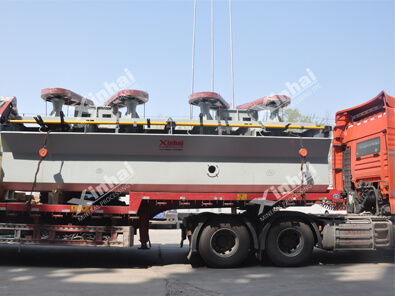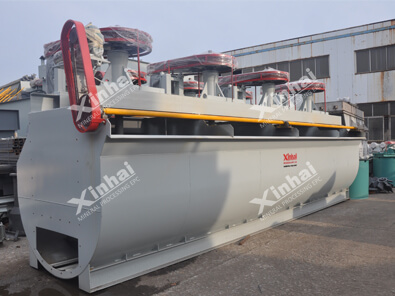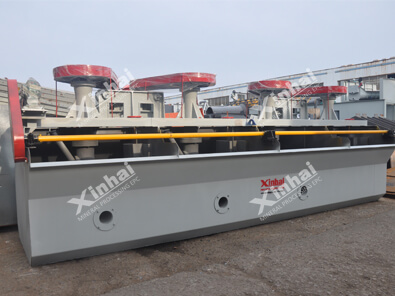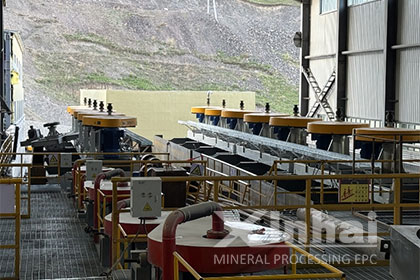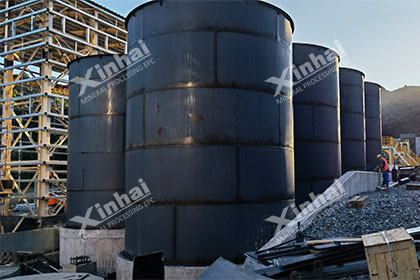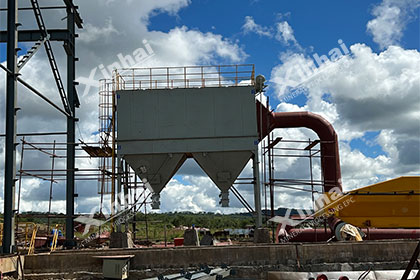You Need to Know 4 Main Methods to Purify Kaolin
 Laura
Laura
 Mar 30, 2023
Mar 30, 2023
 1309
1309
If you want to know more details about equipment, solutions, etc, please click the button below for free consultation, or leave your requirements!
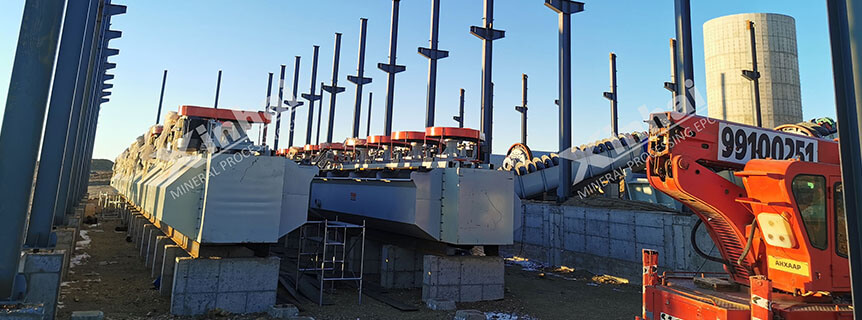
( flotation machines to process kaolin )
As an important mineral raw material, kaolin has been widely used in many fields. Such as ceramic industry, refractory materials and cement industry, paper industry, rubber industry, petrochemical industry, and pharmaceutical and textile industries. Therefore, the purification process and method of kaolin is particularly important, and we will describe them one by one in this article. Let’s start!
01Kaolin Beneficiation Process Methods - Flotation Process
BackAt present, the kaolin flotation process mainly has the following types:
1. Selective Flocculation
Selective flocculation is the use of differences in the physical and chemical properties of the surface of different mineral components, through the preferential adsorption of a certain component surface after the addition of an organic polymer selective flocculant. And then through long-line polymer flocculation The "bridging" effect of the agent makes the particles of this component flocculate into agglomerates, while the particles of other components can still be suspended and dispersed in the pulp, so that the flocs and suspended particles can be directly or indirectly separated conveniently and effectively.
The process of selective flocculation is relatively simple. First, the solid particles in the suspension are fully dispersed, and then flocculants are added to selectively adsorb the target minerals (mineral particles or gangue fine mud). After the target minerals are flocculated, the flocculation is separated from the dispersed phase by means of flotation.
2. Carrier Flotation
Carrier flotation is to use the ore particles of general flotation particles as the carrier, so that the target mineral fine particles are covered on the carrier for flotation. The carrier can be used as a carrier of the same kind of minerals, and can also be used as a carrier of dissimilar minerals.
3. Double-liquid Layer Flotation
The principle of double-liquid layer flotation is to use the difference in the interfacial tension of solid (mineral particles)-liquid (water)-oil three-phase, the difference in the tension of different ore particles at the three-phase boundary, and the difference in the tension of different ore particles in the three-phase boundary. The degree of hydrophobicity between the three-phase interfaces is different, and they will enter different interfaces or phases, so as to achieve the purpose of separation.
02Kaolin Beneficiation Process Methods - Magnetic Separation Process
BackThe dyed mineral impurities in kaolin, such as siderite, pyrite, limonite, hematite, anatase, rutile, etc., have weak magnetic properties. Therefore, the kaolin after desanding is generally subjected to magnetic separation.
Because most of the iron and titanium minerals in kaolin are embedded with fine particle size, the general strong magnetic separation often has a low removal rate. Therefore, most of the industries currently use high-gradient magnetic separators for magnetic separation of kaolin.
High-gradient magnetic separation refers to the selection of small magnetic media under a relatively high background magnetic field to generate a high magnetic field gradient (that is, high magnetic force) on the surface, so as to achieve the purpose of magnetic separation that cannot be achieved by general magnetic separation.
High-gradient magnetic separation has two characteristics, one is to have a magnetic gathering medium (generally steel wool) that can generate a high-intensity magnetic field; the other is to have an advanced screw tube magnet structure. High-gradient magnetic separation technology is very effective for removing weak magnetic fine particles and even colloidal particles in useful minerals. In addition, the superconducting magnetic separator with better performance has also been used in the magnetic separation and iron removal of kaolin. This kind of magnetic separator not only further improves the magnetic field strength, but also can obtain higher quality kaolin, and reduces energy consumption and occupies a small area. .
03Kaolin Beneficiation Process Methods - Chemical Purification and Bleaching Process
BackThere are many specific methods for chemical purification and bleaching, such as the acid treatment method of leaching with hydrochloric acid or sulfuric acid, the chlorination method of turning Fe2O3 into FeCl3 with chlorine gas, the alkali treatment method of leaching with NaOH or Na2CO3, in addition to the oxidation method, Reduction method, oxidation-reduction combined bleaching method, etc.
The chemical treatment of kaolin is often related to the performance of kaolin and the impurities contained in it. The main impurities that affect the performance of kaolin and coal-measure kaolinite are iron minerals, titanium minerals and organic matter. Alkali treatment often does not have much effect. The commonly used chemical treatment methods for impurity removal and purification are mainly acid treatment and chemical bleaching. Law.
Acid treatment and chemical bleaching can also be regarded as two aspects of a method or two stages of a complete process, the two are closely related, the difference is that the main purpose of acid treatment is to remove impurities, The main purpose of bleaching is to change the valence state of the color-causing elements (mainly iron) to weaken the color rendering. In fact, the acid leaching process often adds an oxidizing agent or a reducing agent to achieve the above-mentioned purpose.
Sulfuric acid, hydrochloric acid, nitric acid, hydrofluoric acid, oxalic acid, phosphoric acid, etc. are often used in the acid leaching of kaolin, all of which can react with hematite, limonite, and siderite in kaolinite (soil) to form soluble Salt. After the soluble salt is produced, the iron-containing solution and the purer kaolinite can be separated by washing and solid-liquid separation, so as to achieve the purpose of purification.
The main process parameter of the acid leaching process is the concentration of acid, which largely affects the final effect of impurity removal.
1). Oxidation Method
The chemical purification and chemical bleaching processes are actually combined. Adding an oxidizing agent during acid leaching can oxidize the organic matter and pyrite in kaolin. The oxidation method is also called peroxygen bleaching, which is to oxidize the acid-insoluble iron minerals (such as FeS2) in kaolin (rock) into soluble iron salts and ferrous salts to remove them, and at the same time oxidize organic matter to make them easy to be washed. to a colorless oxide.
Commonly used oxidants are hydrogen peroxide (hydrogen peroxide), sodium peroxide, and sodium hypochlorite. The active component of hydrogen peroxide is H2O2, which will generate HO2- after dissociation. When sodium peroxide meets water, it will first generate hydrogen peroxide, and then dissociate into HO2- and H+.
2). Reduction Method
The reduction bleaching process of kaolin is to reduce Fe3+ in kaolin (rock) to Fe2+, which weakens the coloring ability of iron.
The process of reductive bleaching process of kaolin is to adjust the pH value to 4~4.5 with sulfuric acid in the stirring tank first. Then put it into the bleaching reaction tank, add reducing sodium dithionite, sodium thiosulfate or zinc sulfite (Na2S2O4 or ZnS2O4) , to reduce the ferric iron in kaolin to divalent and dissolve it in the slurry, and then wash it with water to separate it from kaolin.
The process conditions affecting the reduction reaction mainly include pulp concentration, dispersant dosage, sodium hydrosulfite dosage, pH value, reaction time and reaction temperature. Like the oxidation reaction, the reduction reaction also requires the use of additives to adjust the optimal conditions required for the reaction, mainly dispersants, buffers, etc.
04Kaolin Beneficiation Process Methods - Gravity Separation Process
BackThe gravity separation method mainly uses the density difference between gangue minerals and kaolin to remove high-density impurities such as light organic matter, quartz, feldspar and elements containing iron, titanium, manganese, etc., thereby reducing the impact of impurities on whiteness.
The kaolin gravity separation process usually uses a centrifugal concentrator to remove high-density impurities, and can also use a hydrocyclone group to complete the washing and screening operations in the kaolin separation process. The hydrocyclone can not only achieve the purpose of washing and grading, but also remove some impurities, which has good application value.
However, it is difficult to obtain kaolin products that meet the requirements by gravity separation, and finally the final qualified products must be obtained through magnetic separation, flotation, calcination and other methods.
05Summary
BackThe method of beneficiation and purification of kaolin is difficult to obtain high-grade kaolin products only through a single process. Therefore, in actual production, it is recommended that we should choose a manufacturer with beneficiation qualifications, conduct beneficiation tests, and use a combination of multiple processes to obtain Improve the product quality of kaolin. Click the Chat button to learn more about Kaolin Processing.
 +86 183 3575 8886
+86 183 3575 8886 pinklaurabao@gmail.com
pinklaurabao@gmail.com




 Message
Message Chat Now
Chat Now


